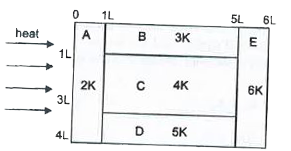Luminosity of sun is 3.9×1026 watts. Mean distance of earth from the sun is 1.496×1011m. What is the value of solar constant ? Solution in Kannada
1.388×105W
1.388×103W m−2
2.776×106W m−2
2.776×104W.
The correct Answer is:B
Luminosity (E ) = Solor constant ×4πR2
∴ Solar const. =E4πR2=3.9×10264×227×(1.496×1011)2
=1.388×103watt/m2.
Thus correct choice is (b).
Topper's Solved these Questions
- TRANSFERENCE OF HEAT BOOK - MODERN PUBLICATIONCHAPTER - TRANSFERENCE OF HEAT EXERCISE - Multiple Choice Questions (Level - III) Questions From AIEEE/JEE Examination)
5 Videos
- TRANSFERENCE OF HEAT BOOK - MODERN PUBLICATIONCHAPTER - TRANSFERENCE OF HEAT EXERCISE - Recent Competitive Questions
4 Videos
- TRANSFERENCE OF HEAT BOOK - MODERN PUBLICATIONCHAPTER - TRANSFERENCE OF HEAT EXERCISE - Recent Competitive Questions
4 Videos
- SOLIDS & SEMICONDUCTOR DEVICESBOOK - MODERN PUBLICATIONCHAPTER - SOLIDS & SEMICONDUCTOR DEVICESEXERCISE - Revision Test
28 Videos
- UNIFORM CIRCULAR MOTIONBOOK - MODERN PUBLICATIONCHAPTER - UNIFORM CIRCULAR MOTIONEXERCISE - Revision Test
57 Videos
Similar Questions
A composite block is made of slabs A,B,C,D and E of different thermal conductivities (given in terms of a constant K) and sizes (given in terms of length, L) as shown in the figure. All slabs are of same width. Heat 'Q' flows only from left to right through the blocks.
Then in steady state

View SolutionTwo slabs are of the thicknesses d1 and d2. Their thermal conductivities are K1 and K2 respectively They are in series. The free ends of the combination of these two slabs are kept at temperatures θ1 and θ2. Assume θ1>θ2. The temperature θ of their common junction is
View SolutionTwo slabs are of the thicknesses d1 and d2. Their thermal conductivities are K1 and K2 respectively They are in series. The free ends of the combination of these two slabs are kept at temperatures θ1 and θ2. Assume θ1>θ2. The temperature θ of their common junction is
View SolutionChoose the forward biased p-n junction :
View SolutionA sphere of mass m is tied to end of a string of length 1 and rotated through the other and along a horizontal circular path with speed . The work done in full horizontal circle is:
View SolutionThe sun's angular diameter is measured to be 1920''. The distance of the sun from the earth is 1.496xx10^(11)m. What is the diameter of the sun?
View SolutionThe distance of the sun from earth is 1.496xx10^(11)m. If the angular diameter of the sun is 2000'', find the diameter of the sun.
View SolutionThe angular diameter of the sun is 1920". If the distance of the sun from the earth is 1.5xx10^(11) m, what is the linear diameter of the sun ?
View SolutionThe total luminosity of the sun is 3.9xx10^(26)W . The mean distance of the sun from the earth is 1.496xx10^(11)m . Calculate the value of solar constant.
View SolutionDuring a total solar eclipse, the disc of the moon almost completely covers the disc of the sun. If the distance of the Sun from the earth=1.496×1011m, diameter of the Sun 1.393×108m, then calculate the diameter of the moon.
View Solution[" The solar constant of earth is "0.8cal/min" - "],[cm^(2)" .If distance of mercury planet from "],[" sun is "0.4" times the distance of earth from "],[" the sun,then find the solar constant of "],[" mercury planet (in cal/min-cm "^(2)" ) "]
View SolutionThe solar constant of earth is 0.8 cal/min.cm? if distance of mercury planet from sun is 0-4 times the distance of earth from the sun then find the solar constant of mercury planet in cal/min cm)
View SolutionThe angular diameter of the sun is 1920''. If the distance of the sun from the earth is 1.5×1011m, what is the linear diameter of the sun?
View SolutionThe angular diameter of the sun 1920^(") Measured. The distance from the earth to the sun is the value of D 1.496 ** 10^(11) m. But what is the diameter of the sun?
View SolutionThe sun's angular diameter is measured to be 1920''. The distance of the sun from the earth is 1.496×1011m. What is the diameter of the sun?
View Solution
